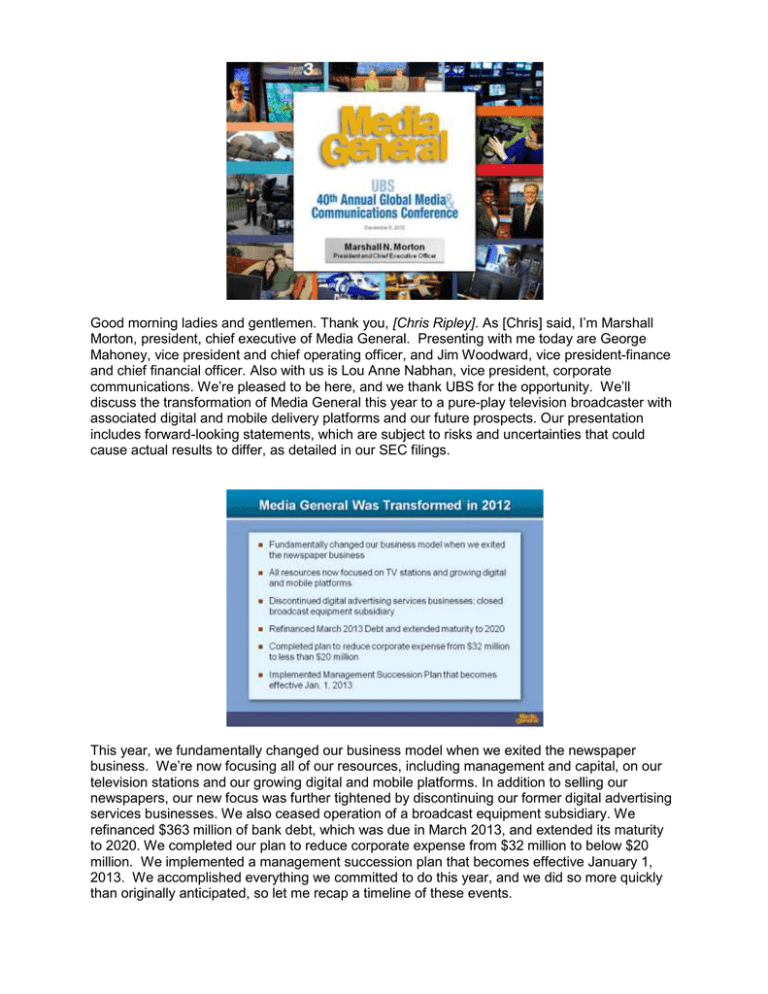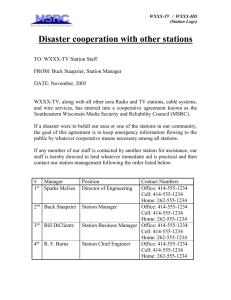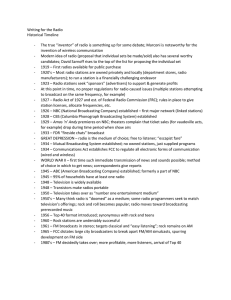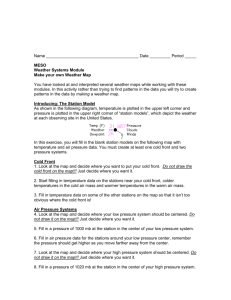UBS_2012 - Media General
advertisement

Good morning ladies and gentlemen. Thank you, [Chris Ripley]. As [Chris] said, I’m Marshall Morton, president, chief executive of Media General. Presenting with me today are George Mahoney, vice president and chief operating officer, and Jim Woodward, vice president-finance and chief financial officer. Also with us is Lou Anne Nabhan, vice president, corporate communications. We’re pleased to be here, and we thank UBS for the opportunity. We’ll discuss the transformation of Media General this year to a pure-play television broadcaster with associated digital and mobile delivery platforms and our future prospects. Our presentation includes forward-looking statements, which are subject to risks and uncertainties that could cause actual results to differ, as detailed in our SEC filings. This year, we fundamentally changed our business model when we exited the newspaper business. We’re now focusing all of our resources, including management and capital, on our television stations and our growing digital and mobile platforms. In addition to selling our newspapers, our new focus was further tightened by discontinuing our former digital advertising services businesses. We also ceased operation of a broadcast equipment subsidiary. We refinanced $363 million of bank debt, which was due in March 2013, and extended its maturity to 2020. We completed our plan to reduce corporate expense from $32 million to below $20 million. We implemented a management succession plan that becomes effective January 1, 2013. We accomplished everything we committed to do this year, and we did so more quickly than originally anticipated, so let me recap a timeline of these events. On February 22, we announced our intent to explore the sale of our newspapers. Our cash flow generation had strongly shifted to our broadcast platform. Broadcast television accounted for 77% of total Platform Cash Flow in 2011. In the first quarter of this year, with Political revenues starting to come in, it accounted for 87%. On May 17, we announced the sale of virtually all of our newspapers – 63 dailies and weeklies - to a Berkshire Hathaway subsidiary. When we began exploring the sale of our newspapers, we had expected multiple transactions. Achieving a single transaction so quickly allowed us to accelerate our transformation to a pure-play TV broadcaster. It also freed up significant management time that would have been devoted to completing several transactions. Also on May 17, we announced a new financing arrangement with Berkshire Hathaway. It provided Media General with a $400 million term loan and a $45 million revolving credit line. The new term loan provides significant financial and operating flexibility. We extended the maturity eight years, and there are no financial covenants. These factors enable us to operate the business with a long-term view. Our relationship is with one lender, rather than multiple lenders with divergent interests. Our next step was to reduce the size of a corporate structure that had been scaled to serve both a newspaper and broadcast company. We committed to reduce corporate expense from $32 million annually to $20 million. On July 31, we streamlined our management and operating structure, and eliminated 75 positions in our corporate departments. We have achieved the $20 million run rate. By August 6, a tender offer to purchase up to $45 million of our outstanding bonds, using proceeds from the newspaper sale, expired. Berkshire Hathaway allowed us to repay at par the amount the bondholders elected not to take, and that was in addition to proceeds that had already been applied. Thus, the Berkshire loan had been reduced from a total of $400 million to about $300 million. On August 22, I announced my plan to retire at the end of this year. With the newspapers sold and debt refinanced, combined with the fact that I turned 67 in October, the time is right. I worked with the Board of Directors for several years to plan for the best management succession. I was delighted that the Board chose George Mahoney to succeed me. George and I have worked together closely since he joined the company in 1993, as General Counsel and Corporate Secretary. More recently, George ran our Digital Media and central Broadcast operations. George has the experience, talent and energy to lead Media General to new successes in a media world that’s making new opportunities available practically every day. George will be supported well by Jim Woodward. Jim led the debt refinance and newspaper sale processes this year, and made a real success of both events. As part of the refinancing, Berkshire Hathaway received warrants to purchase 4.6 million shares of Media General common stock. On September 25, they exercised all of the warrants. Having Berkshire Hathaway as one of our largest equity shareholders is a major positive for the company. On October 8, we sold our last remaining newspaper group - The Tampa Tribune and its associated print and digital products – thus completing our transformation to a broadcast television and digital media company. Media General has a bright future, driven by the tighter operational focus we have today and by strong cash flow, even in the “odd” years. And, now, it’s my pleasure to introduce George Mahoney, who will discuss our operations and growth prospects for the future. Thank you, Marshall. It’s a pleasure to be here, and it’s great to see many familiar faces. I look forward to getting to know our Media General shareholders as well as other investors and analysts who are interested in the industry and our company. It’s a great privilege to lead Media General starting January 1. We’re delighted to enter the new year having completed our transformation to a broadcast and digital media company, and to have refinanced our bank debt. The monumental change away from the newspaper business will enable us to focus on the platforms with strong growth opportunities for the future, including their appeal to the younger demographics. Let me start with an overview of our stations, which are located in strong and growing markets, primarily in the Southeastern United States. All of our 18 stations are affiliated with a major network – NBC, CBS, ABC or CW. Media General got its start in the television business in 1955, when we put WFLA in Tampa on the air as an NBC affiliate. Today, WFLA is our largest station, and Tampa is the 14th largest DMA. Our stations reach more than 8 percent of all U.S. TV households and more than one-third of the TV households in the Southeast. Our network affiliations include eight NBC stations, eight CBS, one ABC and one CW. Five of our NBC stations, one of our CBS stations and our CW station all operate in the Top 50-or-so DMAs. Two-thirds of our stations are ranked #1 or #2 in their market. About the same number of stations rank #1 or #2 for the key news dayparts: morning, 5 p.m., 6 p.m., and Late news. This has been a very strong – and in the best sense of the word, very memorable – year for our stations, with significant growth in all major revenue categories. Political advertising reached an all-time high. We benefited from operating top-ranked stations, where political advertisers prefer to place their ads. Our outlook for Political revenues this year has increased to $64 million, up from our previous guidance of $57-58 million. We capitalized fully on the event-driven revenue opportunities provided by the Summer Olympics and Super Bowl on our NBC stations. Our revenue growth also includes a 75% increase in Retransmission revenues, and a 18% increase in Digital revenues. We’ve seen healthy growth in our core business, driven by increased spending by automotive, financial, grocery, medical, telecommunications and travel industry advertisers. Let me give you some of the details on each of these successes. Our Political revenues reflect the presence of six of our stations in four of the key Presidential battleground states – Florida, North Carolina, Virginia and Ohio. It would be hard as a broadcast owner to imagine a better collection of strategically located stations. Even after the elections, we’ve continued to see Political revenues, mostly from issue advertising related to the fiscal cliff, and some 2014 Senate races. In fact, it took less than a week after Election Day before we started receiving requests for rate quotes in our key battleground states. The money in the door so far truly is a trickle compared to the pre-Election Day torrent – but it’s a testament to the power of television to influence audiences – and behavior – that Political advertising already is returning to us for the next election cycle. Politicians and issue sponsors, like other advertisers, clearly understand the unique strength of broadcast television. Interestingly, about $600,000 of our 2012 Political revenue came online. More came from the Obama campaign than the Romney campaign, and this revenue also compares to a number that, four years ago, would have rounded to zero. We achieved better-than-average market shares from the Obama campaign by being aggressively responsive to early requests for ad space across multiple battleground markets. That early responsiveness, in turn, continued to make the Media General web and mobile sites the go-to places in our markets for the Obama campaign in the mid and later stages of the race. In 2013, there will be a gubernatorial election in Virginia. Combined with some issue advertising we expect in Ohio and elsewhere, we believe Political revenues next year will be at least $5 million. We also note that, of the 33 US Senate races in 2014, Media General stations put a signal over some-or-all of nine of them. The Summer Olympics in London were another important source of revenue growth this year. Our NBC stations took advantage of this most-watched television event in U.S. history. Our stations in Tampa, Columbus, Raleigh, Providence and Roanoke had two advantages for success with the games. One, as the excitement drove viewership, rates increased for all stations, but these markets also saw additional pressure on inventory due to heavy political spending, which allowed us to drive still-higher rates. But even without political pressure, our stations in Charleston, Birmingham and Savannah had revenue gains ranging from 14% to 61% over the 2008 Olympics. Our $15.5 million finish was a 40% increase over the 2008 Summer Games. Of the 56 metered markets, we were delighted that our Columbus, Ohio station was rated 5th for NBC’s primetime coverage during the games. Our stations in Birmingham, Tampa, Providence and Raleigh also showed well. And, of course, the combination of NBC’s storytelling success in London, and our own locally produced Olympics-related programming, portends well for us for the 2014 Winter Games in Sochi. The Super Bowl also was strong for us, generating nearly $3 million of revenue for our NBC stations. Here, too, there was a profitable local dimension: our station in Providence, Rhode Island, did a particularly good job of capitalizing on its proximity to the New England Patriots. In 2013, the Super Bowl will air on CBS, and that has already become a big revenue driver for our eight CBS stations. Next, our Cable and Satellite Retransmission revenues have grown 75% this year. They will be $37 million for the full year. These higher revenues are the result of renegotiations in late 2011, affecting about 25% of the households. We believe we attained competitive rates. On December 31, our retransmission agreement with Time Warner is up for renewal. Negotiations are under way now. Those new rates also will add to our retransmission revenues in 2013 and beyond. On the other side of the same coin, we recently completed our affiliation negotiations with NBC. We’re pleased with the results: a four-year deal – out through 2015 – with competitive rates. Also worth noting: our ABC network agreement renews in the middle of 2014, and our CBS affiliations renew in 2015. This means that this year and next year, we’ll pay affiliate expenses only to NBC. Further, our Digital revenues in 2012 have increased by 18%, and will be approximately $10 million for the full year. Several initiatives in particular will drive our Digital audience and revenue growth next year. We’re migrating all of our stations’ websites to an improved content management system. We’re providing expanded content to further engage users and develop new audiences. We’re increasing our digital advertising inventory. We’re further expanding our online-only sales force. We’re increasing order values and our bundling opportunities. We’re improving the user experience for our desktop and mobile web sites, and for our apps for smart phones and tablets, and we’re even more aggressively promoting our Digital content with social media. Our Digital revenue growth next year should exceed the expected industry average of 21%. We have a history of growing Digital market share at rates higher than the industry. Now, as you’ve no doubt seen, our core business also is very strong. In the third quarter, our gross time sales – excluding Political but including Olympics – grew 17%. Local gross time sales accounted for two-thirds of our core business and increased nearly 16%. National gross time sales grew by more than 19%. Automotive continued to be our largest advertising category, accounting for 23% of our advertising revenues. We saw healthy growth in almost every one of our Top 10 advertising categories. Through the third quarter, core revenues in our audited markets grew 5%, and our stations were up 8.4%. Our total combined market share for our audited stations increased from 23% last year to 24% in this year’s third quarter. For the full year 2012, Media General’s station revenue growth will significantly outperform revenue growth in our markets. And, we expect this betterthan-market growth in our core business to continue next year. We’re out-performing our markets in part because we have more local newscasts. In 2012, we added 13 new newscasts across our stations. The total continues to grow. Our morning news block starts as early as 4:30 a.m. in many markets. We’ve added 7 p.m. newscasts, as well as Saturday and Sunday morning newscasts, at several stations. It’s not unusual for a Media General station to run 35-40 hours of local news each week. Additionally, many of our stations produce local variety shows aimed at specific consumer interests in the market. We introduced 8 of these shows this year and air 37 hours each week of this type of local programming across our stations. These shows feature local hosts and include community events and public service topics. They offer our advertising clients long-form messaging and product placement opportunities. This local content consistently attracts new viewers and advertisers. It reduces syndicated programming expense, while increasing our spot inventory. We think there’s more growth available in 2013 on this front, for both our broadcast and related digital revenue. We’re using our spectrum to multicast at least one subchannel in every market. This programming is advertiser sponsored. While smaller in dollar terms, these revenues will grow 35% this year. Ratings for the CW and MY stations are helping us garner more regional and national advertising buys. These revenues will continue to grow in 2013. We’re also using our spectrum for Mobile DTV, starting in four markets: Tampa, Raleigh, Columbus, Ohio; and Birmingham. We’re a member of key broadcast industry groups that are leading the development of Mobile DTV – Mobile Content Venture and the Pearl Group. These groups are developing the next-generation Broadcast TV delivery for video and data to mobile devices. LG, Samsung and others are taking the lead on providing the chips necessary to receive the broadcast signals on a broad range of mobile devices. Eighteen major broadcast groups provide Mobile DTV in 35 markets, reaching 53% of the U.S. population. While a nascent opportunity, Mobile DTV is one that can expand our broadcast audience and create new revenue streams. Also gaining traction are second-screen viewing capabilities, such as ConnecTV, which Media General offers in five markets. We think something significant will happen here, and we’re pleased to be experimenting with, and learning from, this technology. Media General has a duopoly, in the Greenville-Spartanburg, South Carolina market, where we operate a CBS and a CW station. In Augusta, Georgia, we’ve implemented an operating services model, which we believe bears watching. Our ABC station in Augusta manages the sales and news operations for the Schurz NBC affiliate. We’re paid to run the news, technical, marketing and production operations, and some of their administrative functions. In addition to three new local shows, four newscasts have been added across the Schurz and Media General stations since the inception of this JSA. We’ve additionally captured significant synergies by folding the Schurz operations into our established and very efficient central services for traffic, master control and graphics. This model makes sense in every market in a consolidating industry, but it’s especially important, and powerful, in small and mid-sized markets. It’s now up to us to take advantage of what we’ve learned and apply it elsewhere, strengthening communities -- and also local television broadcasting. To summarize, particularly because of this operating track record and the steps we’ve taken as a company this year, Media General has created a promising future as a television broadcaster, with a portfolio of top-ranked stations, located in attractive, strategic markets. We’re focused primarily on organic growth initiatives in the near term and have in place a number of key revenue building blocks to help us keep increasing our total shares of audience and market revenue. Our stations invest in research, and they have shown they react quickly to changing consumer interests in their markets, and we care deeply about new technology both for the opportunities it presents and to keep our people, and our industry, focused forward. So this is a time of great opportunity for Media General. We have a clear path forward. And we understand well, especially because of our heritage, the importance of being the go-to source for the best local news and information in our communities. I am honored to lead the company starting January 1. And now, Jim Woodward will update you on how these strong operating results and our plans will continue to fortify our financial position. Thank you, George. I’ll start with our debt structure. We have in place the term loan from Berkshire Hathaway, with a face value of $302 million, and a revolving credit facility, with no outstanding balance and availability of $45 million. While interest costs are higher as a result of our new financing, we’ve addressed our long-term capital needs and obtained significant financial and operating flexibility, as Marshall summarized in his remarks. Also outstanding are Senior Notes with a face value of $300 million. These notes mature in 2017 and are callable in February of 2014, at a redemption price of just under 106. Our new financing has improved our overall financial flexibility, allowing Media General to focus on growth in our local markets and shareholder value. The absence of financial covenants allows us to make decisions that are in the best interest of our shareholders, lenders and employees. Because we cannot pay down debt cost effectively at this time, we expect to enter 2013 with a cash balance of $28 million. In 2013, we do not expect to carry an outstanding balance on the revolver. Provided the capital markets are strong and open, we’ll expect to replace our 11.75% Senior Notes that are callable in February of 2014 with less expensive money. Before doing so, we will have the option of using any cash on the balance sheet at the end of 2013 to pay down debt. We retained the pension obligation and related assets for all of the newspapers. Our pension plan was frozen in 2006, and no new participants have joined the plan since that time. Our pension obligations have a payment horizon of 25-30 years, or more with a shrinking population. Over that time, interest rates and investment returns will ebb and flow, potentially creating swings – up or down – in the total liability, plan assets and funded status. At the end of 2011, the total liability was $455 million, and plan assets were $274 million. Our annual payments to participants run around $21 million. Our contribution to the pension plan this year was $9 million, which is lower than our previous estimate of $13 million. The lower amount is due to the funding relief enacted by Congress. Moving to our 2012 forecast, revenues are projected to be $350 million and should generate operating income of $75 million. Station production expenses will reflect the absence of the 2011 furlough program, which mandated most employees take 15 unpaid days. Also included is estimated network affiliation expense for our NBC stations. This is partially offset by lower broadcast programming costs, due in large part to the absence of the Oprah show and a shift towards more local programming. We’re more local than ever in our content, controlling more inventory at lower cost. The absence of the furlough program is also the primary driver of an increase in station selling, general and administrative expenses. Higher commission expense on our increased revenues is also a factor. Corporate expense included $3.3 million of severance costs for the staffing reduction. As reported, we have completed a plan to reduce corporate expense to $20 million, and we will enter 2013 slightly below that run rate. Broadcast Cash Flow is projected to be $141 million this year, representing a margin of nearly 40%. This performance reflects the significant revenue growth we generated in all categories, as well as the rates achieved due to the tight supply-demand balance created by record Political advertising. EBITDA from continuing operations is expected to be $100 million this year, a 28% margin. Included in the $100 million of EBITDA is the $3.3 million of one-time severance cost related to the corporate staff reductions. Cash provided by operations this year has been used to make interest payments of $69 million, capital expenditures of $17 million and the pension contribution of $9 million. We also have non-cash interest expense of approximately $9 million, which includes discounts related to original issue of the term loan, warrants and certain fees that are amortized over the life of the loan. Tax expense continues to be non-cash, largely related to our “naked credit” issue as discussed in our public filings. We expect our Net Operating Loss carryforward for tax purposes to approach $300 million at the end of 2012. This NOL will be available to offset future taxable income for up to 20 years. Therefore, we do not anticipate paying any significant cash taxes for the foreseeable future, and will have a 0% effective tax rate for cash flow purposes. In 2013, interest payments will be slightly lower than this year, due to the absence of one-time interest payments related to the refinancing. Capital expenditures will be approximately $15 million. This includes $6 million for maintenance projects and the balance for growth-related projects, including investments in news gathering and enhanced HD capabilities. The pension contribution will be much lower, at approximately $4.5 million. Looking ahead to next year, we’re still fine tuning our budgets, but I can summarize our key expectations. As is typical in an “odd” year in our business, total revenues in 2013 will decrease from this year, due to the absence of non-recurring Political and other event-driven revenues. On the other hand, we have in place a number of key revenue drivers to help offset these shortfalls from this year, starting with Political revenues of at least $5 million. The Super Bowl on CBS will benefit 8 of our stations. Retransmission revenues will increase. Our Digital initiatives will result in better-than-industry growth. The momentum in our core business is continuing, and this will help us achieve above-market revenue performance. More Local news and programming will provide more inventory. We’ll implement special incentives for volume advertisers and business development programs to grow local time sales. We’ve seen an initial look at the November ratings in our metered markets, and our household numbers are up. It will be late December before the actual numbers are available, but we anticipate a lift next year from the higher ratings. We believe that our market-leading stations will deliver a solid year in 2013. With the transition to a broadcast company behind us, and our full time focus on our broadcast properties, the local markets they serve, and the opportunity that provides us, our 2013 goals are straightforward. They are to: increase our market share, grow our existing products, introduce new products that will serve our local audience and advertisers, and improve our cash flow margins. Plans are either in place or being finalized that will accomplish these goals. We look forward to sharing our results with you and moving ahead with our new business model. Thank you, and now I will turn our presentation back to Marshall. Thank you, Jim. As you’ve heard today, Media General is a much stronger company, with excellent future growth potential, based on our new model as a broadcaster. With our exit from the newspaper business, all of our attention, focus and resources are being directed to our market-leading television stations and our growing digital and mobile delivery platforms. Our operating results and cash flow are strong, even in “odd” years. Our new business model and financial flexibility provide us with the opportunity to invest all of our capital in our broadcast and digital operations. We’ll focus on progressively increasing cash flow margins at our stations, by driving ratings and share increases, as well as through expense management. We will delever over time, starting with the refinancing of our 11-3/4% notes. The strong management team I’ve been working with for years is primed to lead the company starting January 1. I’m confident that they – and all of our employees – will make the most of the expanded opportunities provided by our new business model. And now we will be pleased to take your questions.





